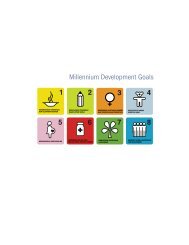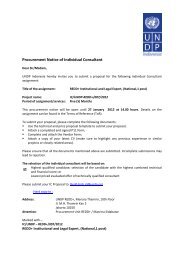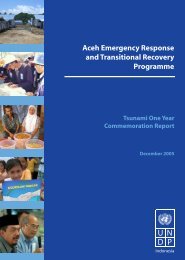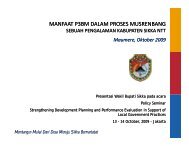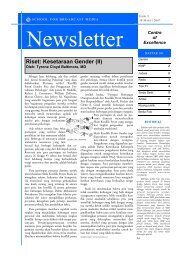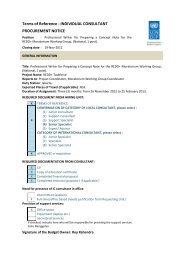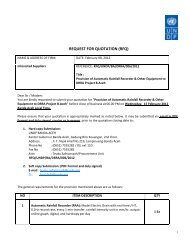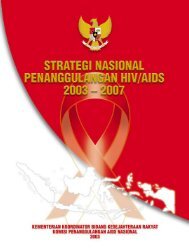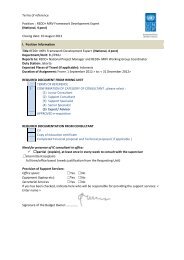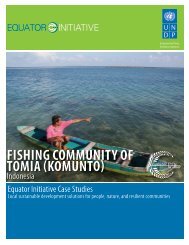Download the Indonesia Human Development Report 2004. - UNDP
Download the Indonesia Human Development Report 2004. - UNDP
Download the Indonesia Human Development Report 2004. - UNDP
You also want an ePaper? Increase the reach of your titles
YUMPU automatically turns print PDFs into web optimized ePapers that Google loves.
to meet <strong>the</strong> Millennium <strong>Development</strong> Goals (MDGs). Therights approach is also particularly appropriate for supporting<strong>Indonesia</strong>’s radical process of decentralization: at <strong>the</strong> nationallevel much of <strong>the</strong> debate about economic and social rightshas to be pitched in a general way, but at <strong>the</strong> local level <strong>the</strong>recan be a much more dynamic interaction between providersof services and users. So while <strong>the</strong> central government canmandate minimum service standards <strong>the</strong> achievement of <strong>the</strong>sestandards can best be monitored at <strong>the</strong> local level.Counting <strong>the</strong> costWhat would it take to fulfil <strong>the</strong>se rights and in particularto ensure that everyone received essential health care, had agood basic education, had enough to eat, and felt safe andsecure?HealthGood health is <strong>the</strong> outcome of many different factors,including poverty, environmental circumstances, and mattersof personal behaviour. But it also depends on <strong>the</strong> availabilityof effective health services, particularly at <strong>the</strong> communitylevel. Nowadays <strong>the</strong> public health network is extensive andwell distributed across <strong>the</strong> country, however <strong>the</strong> quality isoften low – one of <strong>the</strong> reasons why many people opt forprivate care.Costing <strong>the</strong> required state investment in health is difficultsince funds could usefully be directed to many different areas– from building better infrastructure for water and sanitation,to improving <strong>the</strong> environment, to limiting vector-bornediseases. Funds could also be productively invested in heal<strong>the</strong>ducation – both for preventive measures and also toencourage better ‘health-seeking behaviour’ so that peoplemade <strong>the</strong> right choices when faced with health problems.Probably <strong>the</strong> simplest way to estimate <strong>the</strong> costs is toconcentrate on <strong>the</strong> health needs of <strong>the</strong> poor. The World Bankhas estimated that a basic health package for everyone in <strong>the</strong>country would cost Rp. 10.7 trillion. However this does notinclude hospital or in-patient care. The Ministry of Healthhas <strong>the</strong>refore made a proposal for extra funds to cover this in<strong>the</strong> form of a ‘poverty health grant’ which could be distributedto districts on <strong>the</strong> basis of <strong>the</strong>ir individual needs. This wouldadd Rp. 2.9 trillion, making a total of Rp. 13.6 trillion. Currentexpenditure on primary care is Rp. 8.4 trillion suggesting that<strong>the</strong> required increase to guarantee basic health rights is Rp.5.2 trillion.EducationThe best estimates of what it would cost to fulfil <strong>the</strong> rightsto basic education have been produced by <strong>the</strong> Ministry ofNational Education in its National Plan of Action: <strong>Indonesia</strong>’sEducation for All. This report estimates what it would take tooffer equal access for all boys and girls to high qualityeducation. This concludes that <strong>the</strong> annual ‘ideal’ expenditureper pupil should be Rp 1.17 million at <strong>the</strong> primary level andRp. 2.28 million at <strong>the</strong> junior secondary level. On this basis, tofulfil <strong>the</strong> right to basic education would require an increasefrom Rp. 33 trillion to Rp 58 trillion. This may seem a dramaticrise but in fact <strong>Indonesia</strong>’s Constitution already commits <strong>the</strong>country to spending more than this.Poverty and <strong>the</strong> right to foodThe cost of guaranteeing food security can be estimatedfrom <strong>the</strong> numbers of those living in poverty. Someone isconsidered as living below <strong>the</strong> poverty line if <strong>the</strong>y do nothave sufficient resources to consume 2,100 calories per dayand also to purchase essential non-food items such as clothingand shelter. In 2002 to afford <strong>the</strong> basic minimum foodrequirement <strong>the</strong>y would have needed Rp. 82,328 per personper month while for <strong>the</strong> non-food items <strong>the</strong>y would haveneeded Rp. 28,957. Since both food and non-food items areconsidered essential, effectively everyone who falls belowthis poverty line is food insecure – 18% of <strong>the</strong> population, 38million people.The most direct way to eliminate poverty now would be togive <strong>the</strong> poor sufficient funds to purchase both food andessential non-food items. This would cost around Rp. 8.4trillion. However, if <strong>the</strong> health and education investmentsindicated above had been made, this in itself would havealready reduced poverty by reducing <strong>the</strong> cost of <strong>the</strong> nonfooditems. One way of accounting for this would be toguarantee food security only to <strong>the</strong> 4.4% of <strong>the</strong> populationwho fall below <strong>the</strong> Rp. 82,328 food poverty line. The totalannual cost of distributing food to this group would be Rp.3.68 trillion. This is Rp. 1.09 trillion less than <strong>the</strong> existing Raskinfood subsidy programme, largely because it aims to cover asmaller group of people.Physical securityImproving physical security would demand wide-rangingreforms – in <strong>the</strong> justice system and in <strong>the</strong> police force. If <strong>the</strong>aim were to improve <strong>the</strong> quality and effectiveness of policingin addition to better training and supervision this would requireadequate numbers of police personnel who were sufficientlywell paid that <strong>the</strong>y did not resort so readily to corruption.How much would it cost to offer more reasonable policesalaries? Currently <strong>the</strong> annual budget for <strong>the</strong> police is Rp. 7.5trillion. Setting <strong>the</strong> wages according to Malaysian orSingaporean standards, for example, would mean that currentwages would have to be roughly quadrupled, increasing <strong>the</strong>total budget to Rp. 26.7 trillion. This sum would be even largerif <strong>the</strong>re were more police: if <strong>the</strong> ratio of police to populationwere improved from <strong>the</strong> current level of 1:798 to <strong>the</strong> ASEANstandard of 1:400 <strong>the</strong>n <strong>the</strong> cost would increase to Rp. 53.3trillion. An alternative would be to choose <strong>the</strong> current ratio inJakarta of one 1:750 and set this as <strong>the</strong> national target. In thatcase, <strong>the</strong> estimated annual cost of providing physical securityby increasing police salaries and numbers becomes Rp. 28.4trillion – an increase of Rp. 20.9 trillion.The total costThese estimates for fulfilling rights to food security, tohealth, to education and physical security, can only give ageneral indication of requirements. And it should beemphasized that <strong>the</strong>y largely refer to routine costs ra<strong>the</strong>r thanto development or capital costs. Contrary to <strong>the</strong> conventionalassumption, however, <strong>the</strong>y do show that in both political andfinancial terms meeting <strong>the</strong>se rights should be well within<strong>Indonesia</strong>’s reach. The totals are indicated in <strong>the</strong> table below,suggesting that public expenditure on <strong>the</strong>se sectors wouldneed to increase from 3% of GDP to 6%.National <strong>Human</strong> <strong>Development</strong> <strong>Report</strong> 2004 3



